Mar 26 2017
sanderroosendaal
Posts by Sander Roosendaal:
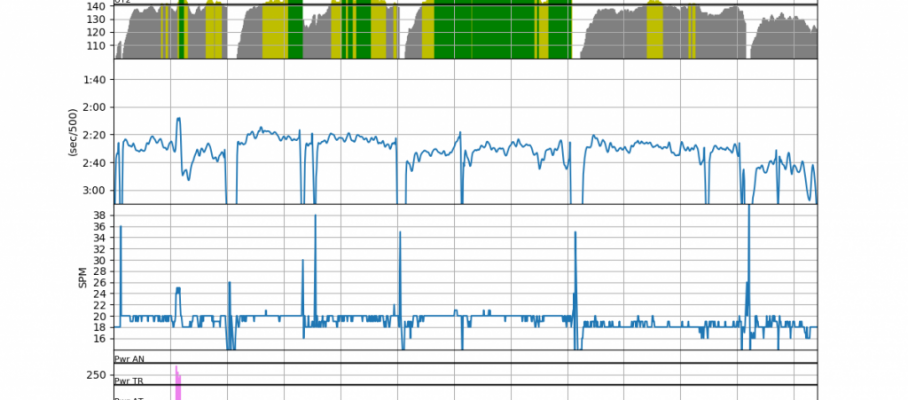
Mar 25 2017
Sunny Steady State Session (SSS session)
This was just a very nice morning at the rowing club. Arrived at 9:30, in time for my son’s training time. Lenka helped me swap the oarlock pins on my single for better ones. Since I have backstays, I need the screw-thread on the top of the pin to be longer for all the bolts to fit on nicely. So that is now the case.
Then I took the single for this year’s first row on the lake.
Here is the graph from rowsandall.com:
During the row, I had set the SpeedCoach monitor to the most basic parameters you can have: Stroke Rate, Pace, Distance and Elapsed Time. I just focused on rowing. It was nice weather. This was a 12km steady state. I was tired from the week in Račice, and I didn’t feel like focusing on complex parameters.
The Empower Oarlock magnet moved a bit during the row. Even though I had screwed it tight. I suspect that the new pins are a bit greasy. This made the catch and finish angle measurements unusable, but all the other metrics are still valid. I leave it as an exercise to the reader to spot the headwind and tailwind segments. As a hint, the nearest airport (16km) reported 3kt wind from the North.
After the row, I took out our double and rigged it. It was nice to stand in the sun, mess around with a double, and chat with the other rowers.
I fell asleep in my chair while trying to process my workout. I guess I have some lack of sleep and accumulated fatigue.
I hope to persuade Romana to go for a technique outing in the double, followed by a sauna session. By the way, Romana was in Pardubice today to do rowing trainers’ exams. She passed. Yay! Now she is officially certified.
By sanderroosendaal • Uncategorized • 0 • Tags: lake, OTW, rowing, single, steady state, training
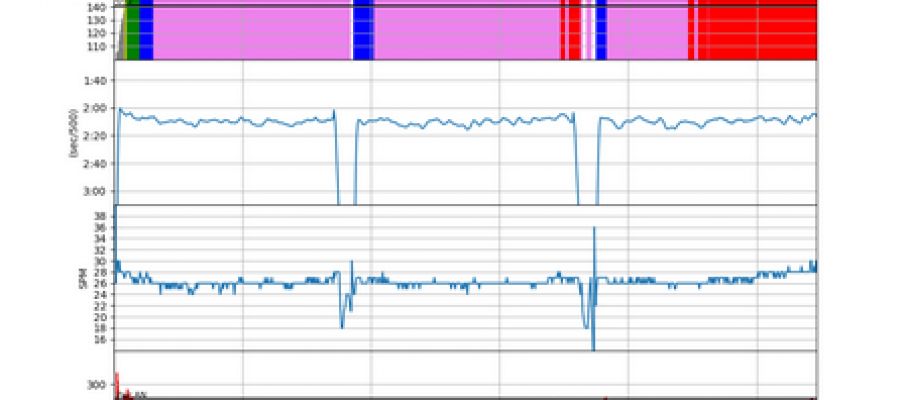
Mar 24 2017
The Proof of the Pudding – a 6k head race test with power meter
So yesterday I had some theories about how you can use the metrics of a power measuring oarlock (the NK Empower Oarlock in this case) to find an optimum race strategy and keep an eye on technique during the race.
This morning I tested some aspects of this theory. This is part of the philosophy I have for the rowsandall.com rowing data analytics site. I will try to test as much as I can so that you, the users, can be sure that what we recommend has been tried and tested. We (that is I and our alpha and beta testers) use all the apps that the site is compatible with and we make quick adjustments when something doesn’t work.
Back to the 6k test now. First, I did a 2k warming up:
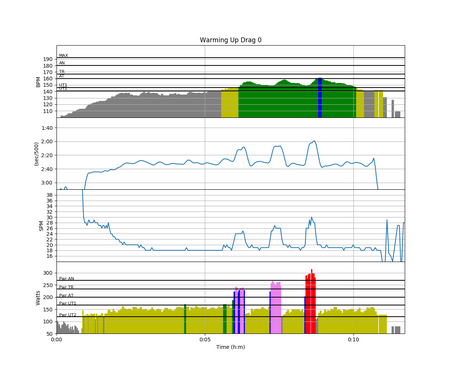
After that is was time for the proof. I set the SpeedCoach display as follows:
-
Top Left: Stroke Rate
-
Top Right: Instantaneous Power (Watts)
-
Bottom Left: Effective Stroke Rate (degrees)
-
Bottom Right: Work per Stroke
For (4), you could argue that I should have chosen maximum or average force, but the problem was that I didn’t have a feel for the data. This is partly my own fault. On the site, I am using pounds, a horrible American unit, while the SpeedCoach uses the perfectly sound Newton. I need to convert the site to Newtons. I don’t think anyone will object. For now I use work per stroke, though, because I feel I shouldn’t go above 550 J or below 500 J.
The effective stroke length is the stroke length minus slip and wash, so it is the arc through which you are effectively pulling. Stroke rate was there to check that when the other metrics tell me to lighten up and rate up, I am actually achieving that goal.
So, no pace information? No distance? Correct. As I was rowing on a 2k FISA compliant race course, I had enough visual clues about my position, with a sign every 250m, and a sequence of buildings as you approach the finish line. And pace? I decided that pace was irrelevant. (I did cheat a little, because my Garmin watch on the scull provided pace in time per km, so a division by 2 would give me the infamous pace per 500m.
There was a light wind, which would be a headwind in the first and last 2k sections. After each 2k section, I would have to quickly turn. I contemplated setting the row up as a 3x2km workout with 1 minute rest, but decided I wouldn’t do that. I rowed it as a Just Row.
Here are the results:
Workout Summary - media/20170324-083240-SpdCoach 2136923 20170324 0726amo.csv
--|Total|-Total-|--Avg--|-Avg-|Avg-|-Avg-|-Max-|-Avg
--|Dist-|-Time--|-Pace--|-Pwr-|SPM-|-HR--|-HR--|-DPS
--|06117|27:20.0|02:14.1|225.9|26.3|173.9|185.0|08.5
W-|05908|25:36.0|02:10.0|232.8|26.4|174.0|185.0|08.7
R-|00211|01:44.0|04:06.0|099.1|24.0|171.9|185.0|00.0
Workout Details
#-|SDist|-Split-|-SPace-|-Pwr-|SPM-|AvgHR|MaxHR|DPS-
00|01968|08:33.0|02:10.3|234.7|26.4|167.0|177.0|08.7
01|01976|08:34.0|02:10.0|231.0|26.1|175.4|181.0|08.8
02|01963|08:29.2|02:09.7|232.7|26.8|179.6|185.0|08.6
In graphs:
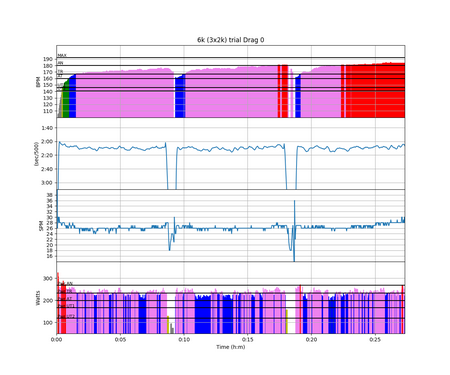
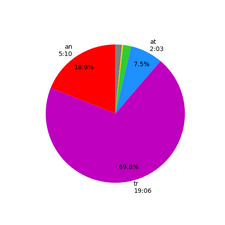
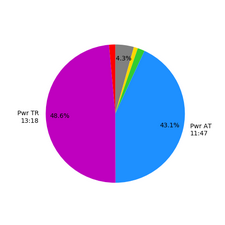
I wasn’t entirely sure about the ideal Power value, but I guessed that 250W would be too much, and I took Monday’s 4x2km at 211W as the lower boundary. In the end that worked out to 233W average. During the row I saw it vary between 210W and 250W. Some of that was due to course corrections (the wind was a headwind but also a slight crosswind). I was worried about the low stroke rate, but I also know it takes a few of these trials to get the stroke rate higher. I decided to stop worrying about it and focus on length, power, and work per stroke.
The effective length was a bit lower than I had hoped, and I consciously worked to get the values above 90 degrees. But then, I didn’t want to look at the SpeedCoach for each and every stroke, so the values slipped a bit as I got tired. I think you can also see that my effort was quite constant in the end.
The question is always if I could have gone faster. In a 6k race, on race day with the adrenalin, and without the turns, I think I could. But still it will be a smart strategy to stick to these values for the first 4.5km, and only go faster in the final stretch.

Drive length oscillating around 89 degrees (would have liked to see a bit more there).
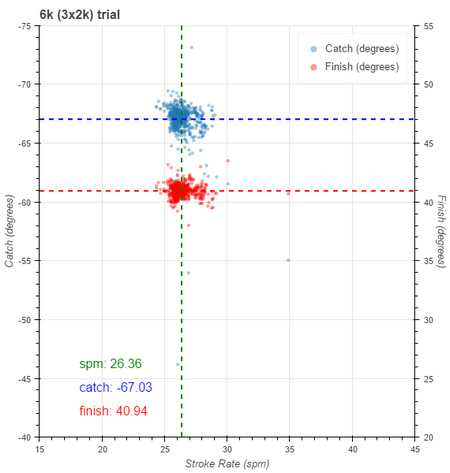
Catch and finish angles in a pretty narrow range.
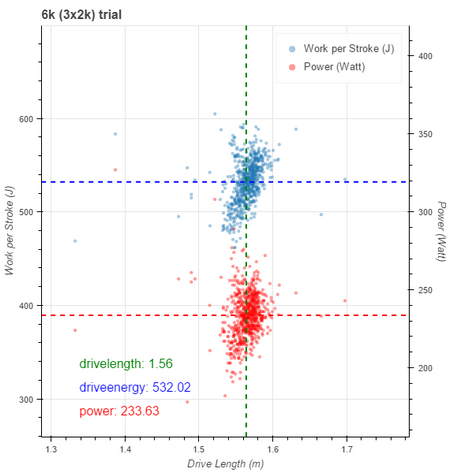
It looks like work per stroke and power are mainly determined by the drive length.
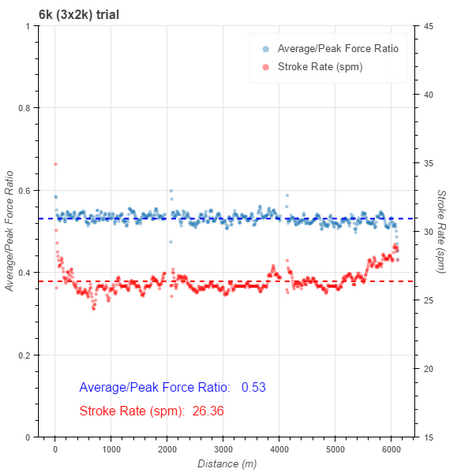
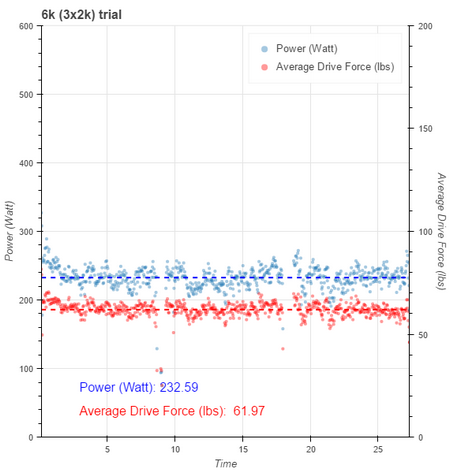
Pretty constant in the average drive force. This tells me that most of the Work per Stroke variations are from the effective drive length.
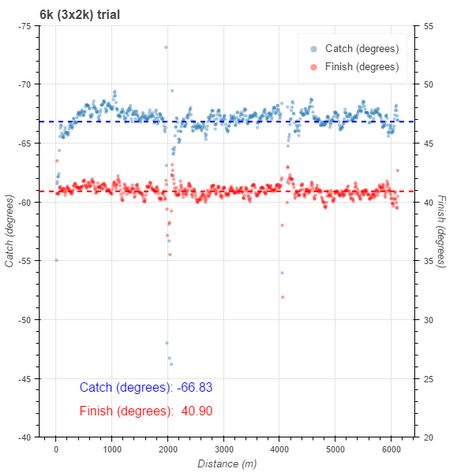
Not sure what the big differences in catch angle mean.
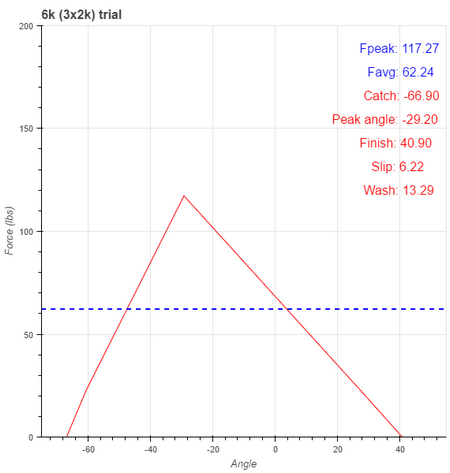
By sanderroosendaal • Uncategorized • 1 • Tags: 6k, 6k trial, head race prep, OTW, rowing, single, training
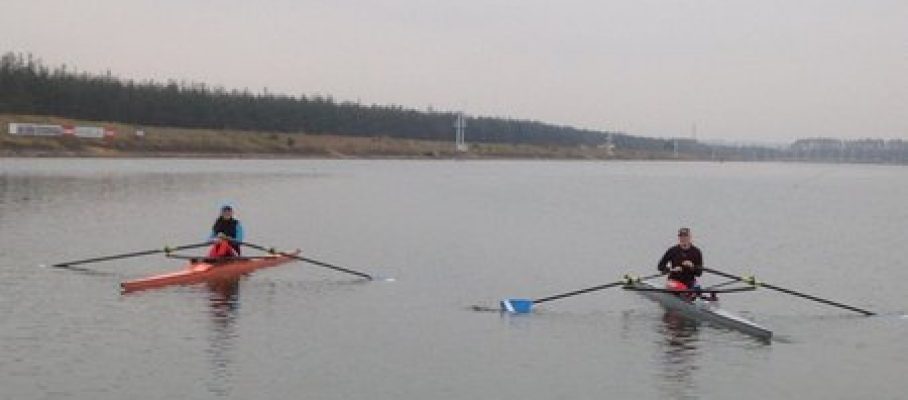
Mar 23 2017
Thursday – Racice day 4 – finding the sweet spot
The training plan said:
Warming up. 4km 10 strokes on / 10 strokes off. Then Steady state.
And that is almost exactly what I did. I kept the stroke rates in check in the “on” intervals, because I am looking for that ideal 6km head race stroke.
Still, looking at Power, I went way above 300W. On Monday’s 4x2km training, I only managed 211W average. So clearly 300W is not sustainable. Even if I take into account that on Monday I was still recovering from the week in the US.
I set the SpeedCoach to show stroke rate, pace, as well as Work per Stroke and Power, and looked at the Work per Stroke numbers at steady state pace. Then I did 250m intervals at higher stroke rate, but keeping the Work per Stroke around the same number. That way, I found this perfect light 30spm stroke which I think may be sustainable. I will check tomorrow.
I have this working hypothesis that the ideal stroke is in a sweet spot where three parameters are optimized, a bit like in the following picture:
The ideal power is given by the length of the race, so it has a narrow range where you can slightly negative split over the entire length of the course.
The ideal stroke length (given optimal foot-stretcher setting) is given by a minimum catch angle to work in the effective range, and the maximum catch angle that you can achieve. Arguably you should use “effective stroke length”, which gives you an additional penalty for slip and wash.
The ideal stroke (average) force has an upper bound. If you cross that, muscle fatigue will slow you down even when your fitness would allow you to continue at given power.
If you pick power, stroke length and average force, you basically have fixed stroke rate, stroke rhythm, and all the other parameters.
Of course, for sprint races, a similar diagram can be drawn but the values will be somewhere else.
It’s just a theory. And there may just as well be three other parameters to look at. During the row, I looked at Work per Stroke (which is stroke length times average force) and Power.
The nice thing about these metrics is that they are actionable. In the middle of a race, you can actually monitor these parameters on the SpeedCoach, and when they are not in the right range, you know exactly what to do. If I had to monitor “check” or some other complex parameter, I would find it difficult to act if the metric was outside the optimum range. I personally think this is extremely important. For rowing data analytics, we must focus on metrics that are easy to communicate, meaningful (as in influencing boat speed) and actionable.
So here is today’s training:

Zooming in to find that Sweet spot:
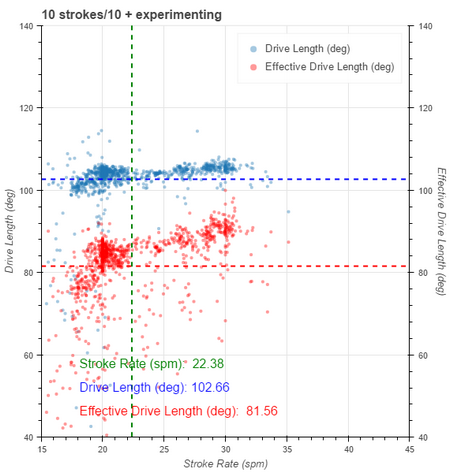
Drive length is nearly constant, but effective drive length increased with stroke rate. Not sure if that is good, but it is probably also a consequence of how “slip” and “wash” (and thus effective drive length) are defined in the NK world.
The left-hand side plot shows power and average drive force. The right-hand side plot show work per stroke and stroke rate. The green area shows where I tried to find the sweet spot (in terms of work per stroke). The blue dots that are higher are from the 10/10 stroke intervals, where I pulled too hard.
That was my training.
The canal was really busy today. In the morning, there was a FISA visitation related to the upcoming European Rowing Championships. Then Czech TV arrived and started filming. “Our” girls Lenka and Iva even gave interviews for the TV. After that, there was a press conference.
In the afternoon I swapped the Empower Oarlock to Iva’s boat and set her up to monitor Finish Angle and Wash. I told her to keep finish angle at 40 degrees (which she did) and wash below 20 degrees, or as low as she could (which she didn’t). This shows how we have to learn to work with the oarlock as a technique tool. I forgot to tell her what the number is, and how she could work on reducing it (because it was clear in my mind). So the metric was not really actionable for her.
So in the end she didn’t improve too much, even though visually it looks like her layback has improved over the week. I took a closer look at her rowing and I think there is also an element of “blades popping out of the water” in the last part of her stroke. Even with a slightly less exaggerated lean back, there just isn’t a lot of power in the last part her stroke. After the row, we showed the data to her again, and I told her she can go a lot further on every stroke if she finishes strong. It will be interesting to see if that sticks.
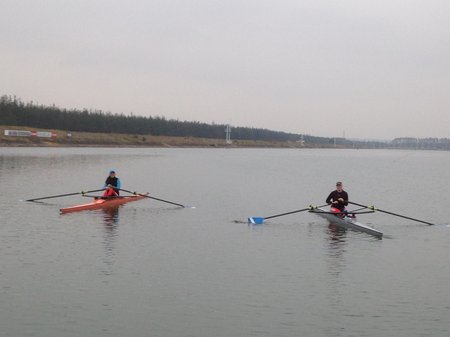
By sanderroosendaal • Uncategorized • 0 • Tags: head race prep, OTW, rowing, single, training
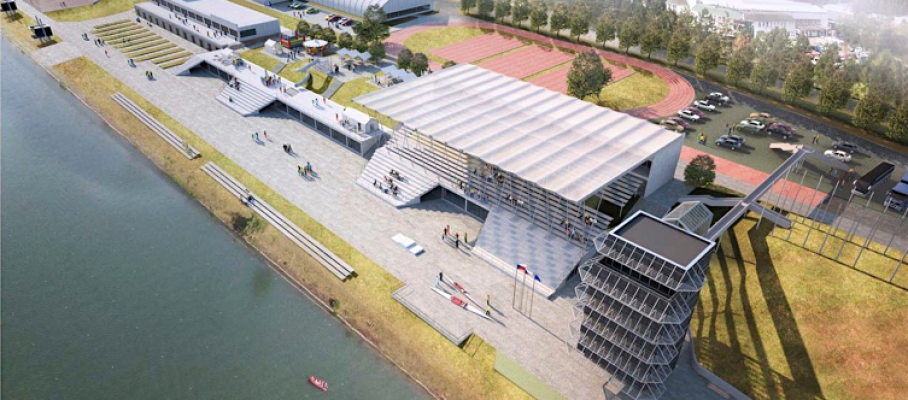
Mar 22 2017
Račice day 3 – Steady State
Steady state row before breakfast. Breakfast. Drive to Prague. Traffic Jam. Park at first Underground station. Metro to work. Work. Metro back to other side of the city. Drive back to rowing canal.
Is there more I can say about today’s workout, you’re asking?
Yes, there is. Even though this was a time-pressed steady state at 18spm, there are a couple of things I would like to mention.
First, even though it started raining lightly during the workout and the temperatures were a lot lower than yesterday (about 3 degrees C), this was a superb row. The water was mirror flat, and I was the only person on the water. The birds were singing. The water was so flat that I did use the first 2k for drills, drills, drills. On our moody home lake, the water often is not suitable for doing drills.
Second, I tried a new thing. The Empower Oarlock with the SpeedCoach set to the “skills” display. I chose to work on finish angle and wash, which seemed a good one after the square blade rowing I had finished the drills with.
The SpeedCoach/Oarlock/HR belt combo hung up on me after about 3/4 of the workout, so the graphs come in two parts.
Here are the metrics plots. I still have to get a feel for it, but I think the Wash values are good for 18spm (at higher rates and pressure it is easier to get to lower slip and wash values). I also noticed that, indeed, when focusing on good form and a clean tap-down, the wash number was lower. When I concentrated, I could get the value below 10 degrees.
I am also quite proud on the constant stroke rate in the second part of the workout. Mind you, I only had finish angle and wash on my display. No other information. No stroke rate, no pace.
They are working hard to renovate the rowing canal and be ready for the European Championships in May. Here is an artist’s impression of the end state:
Most of it is done.
By sanderroosendaal • Uncategorized • 0 • Tags: OTW, rowing, single, steady state, training

Mar 21 2017
Račice day 2 – Sprintervals
Alarm clock at 5:30, pushing off the dock at 6:00. With the jet lag and everything I had expected this to be very hard, but I hopped out of bed with no problem. Then I had the canal for myself and mirror flat water. Heaven!
The session was Nx30″/60″ with N being the number of intervals that fit into three straight 2k segments. In the end N turned out to be 21, if I count correctly.
On purpose, the breaks were long enough to allow me to focus on form, rather than going into workout survival mode. I think that paid off. As the intervals progressed, I got back that boat feeling (that one so successfully destroys when stuck to the static erg) and was able to see some nice pace numbers (1:48 was the lowest split I saw).
A slight adjustment in the foot stretcher. I think I am where I want to be now.
Here are the pie charts:
I was curious to see the technique metrics (slip, wash, effective length vs total length, etc) for this first time in the season I have consistently worked above 30spm on the water.
I think the slip and wash numbers look pretty good. I am wondering whether the numbers given by NK in their guidance are for race pace, because I get higher numbers for the paddling and steady state. Paddling between the intervals, both stroke length and effective stroke lengths are shorter, but this was just me paddling really easy. In most of the graphs above, I have selected only the “work” strokes. Here is the drive length graph for all strokes:
After the workout, I drove to the P+R just north of Prague and took the metro to our office on the other side of the city. It took me more than 90 minutes door to door, but the 45 minutes on the metro were usable for reading and working, so not much time lost.
Tomorrow: Steady state, again in the early hours. It will be just me, mirror flat water, and birds singing in the forests around the canal.
By sanderroosendaal • Uncategorized • 2 • Tags: OTW, rowing, single, sprintervals, training
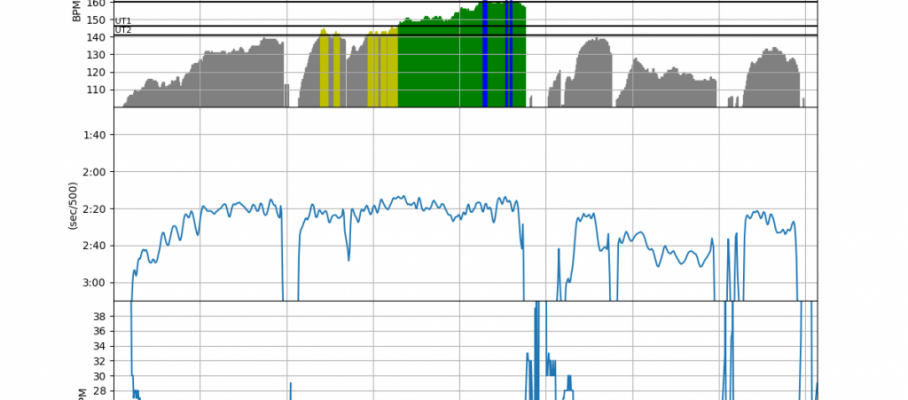
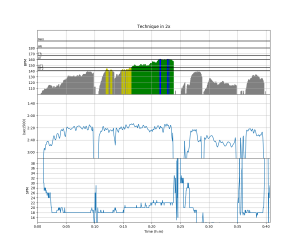
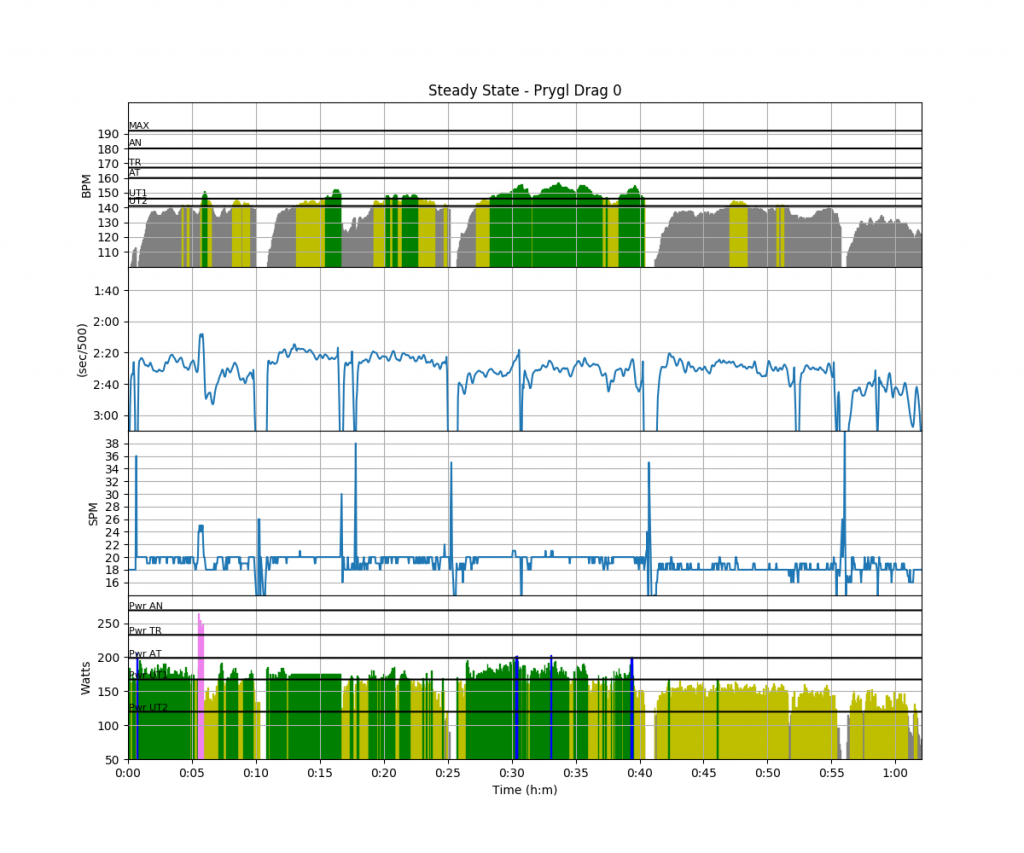
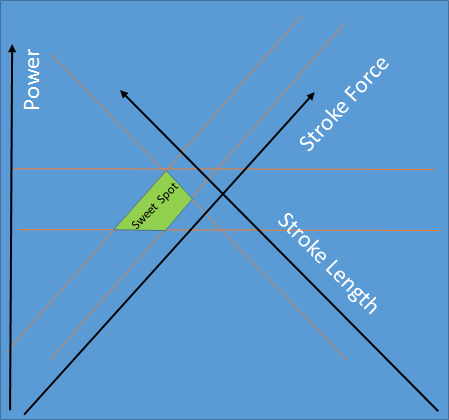
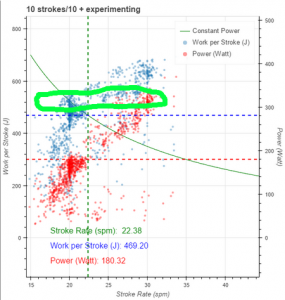
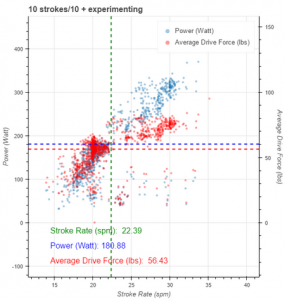
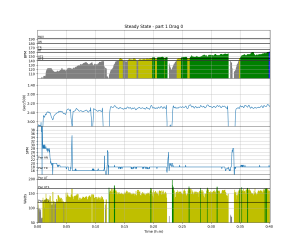
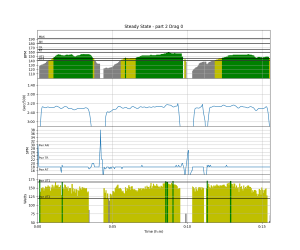
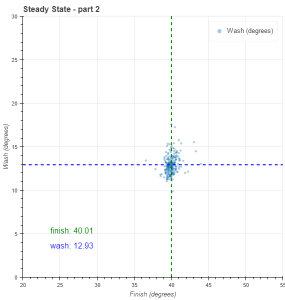
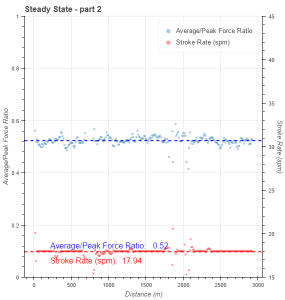
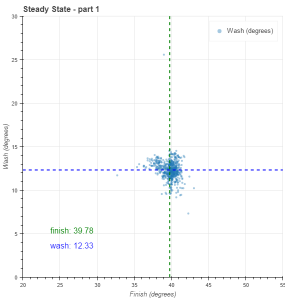
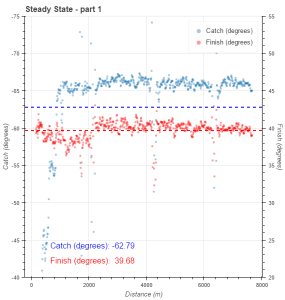
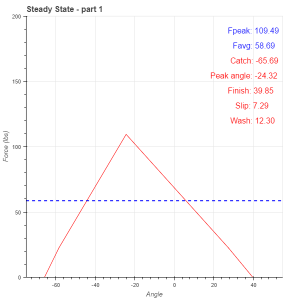
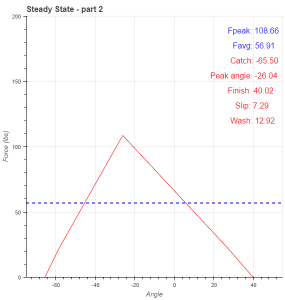
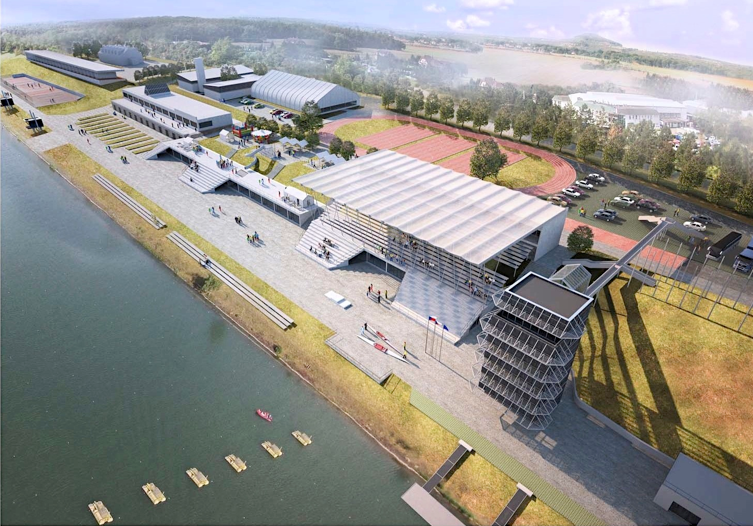
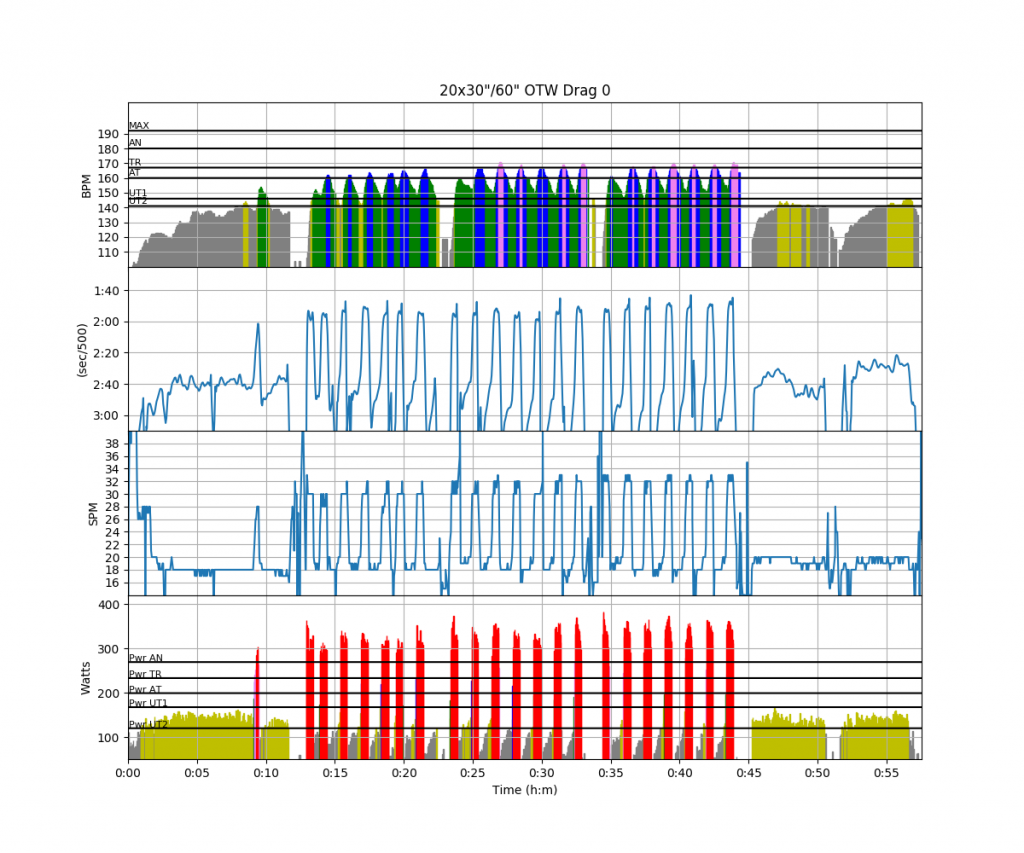
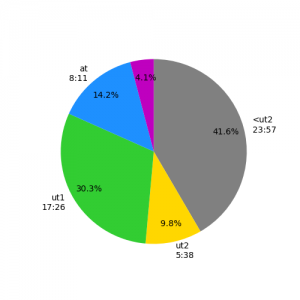
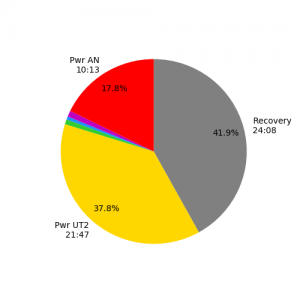
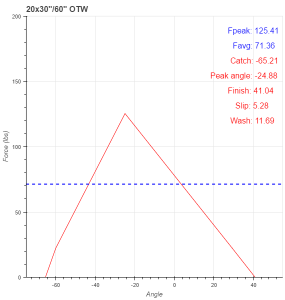
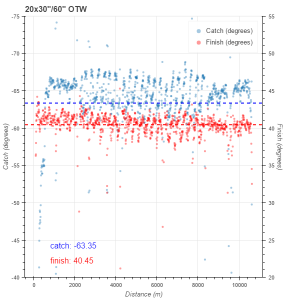
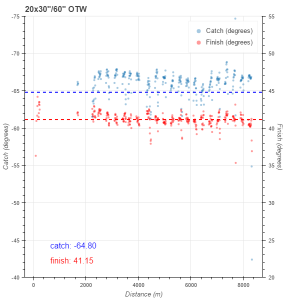
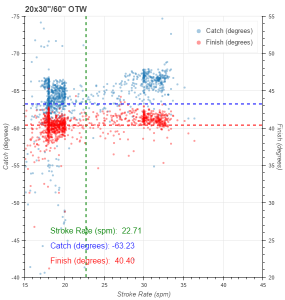
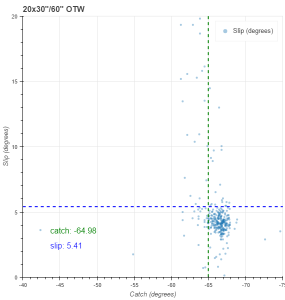
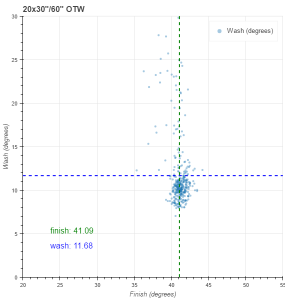
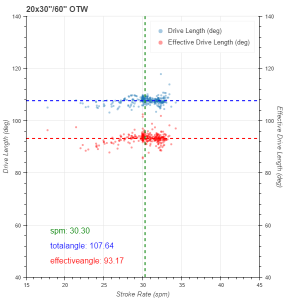
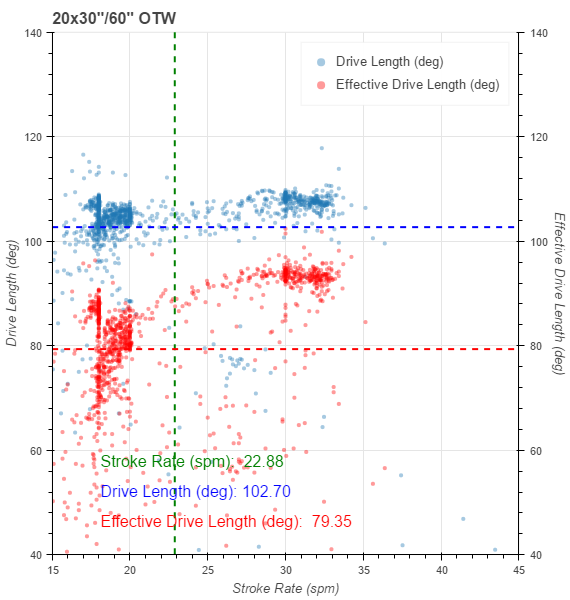

Mar 28 2017
Monday – Guest row with the double
Arjan is my old training partner when we were both studying in Utrecht and rowing for Orca. He is over in Vienna for a week long conference, decided to fly in half a day earlier and hop on the train to Brno. I picked him up at the railway station at the end of the afternoon and we headed to the lake.
We took the double “Orca” for a tour of the lake. We rowed up to the castle and then crossed the lake. This was a steady state session so we did most of it at 20spm, with an occasional excursion to 22spm. Arjan really enjoyed the scenery. In Weert and Eindhoven they are rowing on narrow canals in an industrial setting, so being in the middle of a forest, in a canyon, between rocks, was quite a change for him.
He also needed some time to get used to navigating on the lake.
Then we went to my place to have dinner, chat a bit, and at in the end I brought him to the last train to Vienna.
This morning the alarm clock rang at 5AM. At 5:30 the driver was already waiting. I hopped in the car and headed to the Vienna airport. I took the flight to Brussels. First time I flew on a Sukhoi SSJ100 aircraft, operated by City Jet for Brussels airlines. Lots of leg space!
Tomorrow morning: Hotel gym workout.
By sanderroosendaal • Uncategorized • 0 • Tags: 2x, double, lake, OTW, river, rowing, training